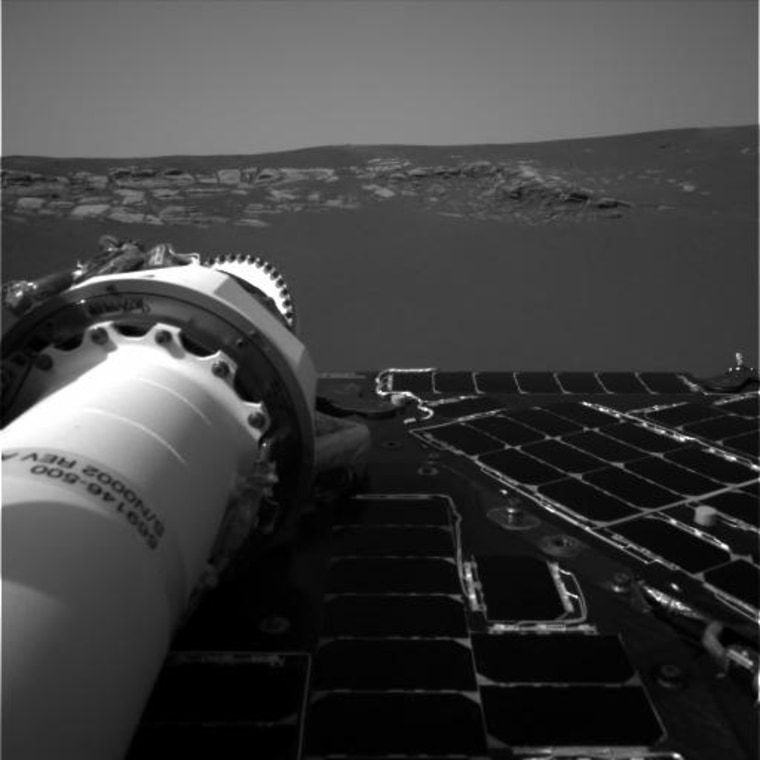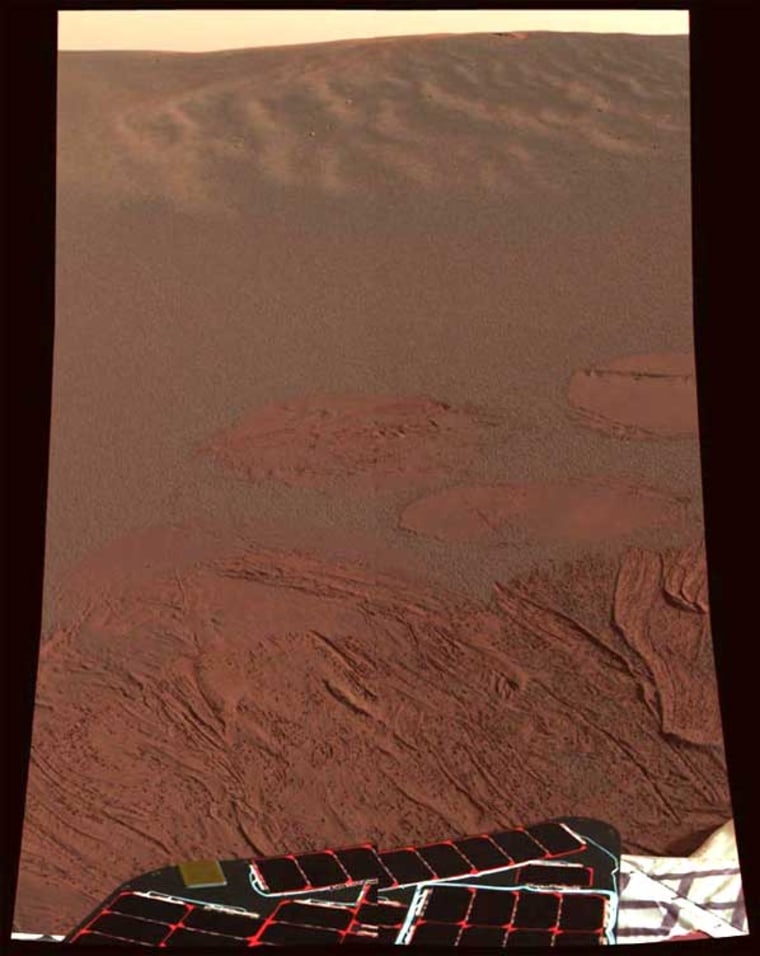Exactly three weeks after its identical twin set down on Mars, NASA’s Opportunity rover landed late Saturday and sent back pictures of Martian terrain unlike any seen before.
Scientists had expected that Opportunity's landing site would look markedly different from the rock-strewn landscapes that surrounded the Spirit rover as well as the Pathfinder and Viking landers — and they were right.
The first crop of black-and-white pictures showed what appeared to be a plain of dark soil so fine it was imprinted with the trails of the airbags that cushioned Opportunity's landing. In the distance, blocky slabs of lighter rock poked up through the soil.
"I'm flabbergasted. I'm astonished. I'm blown away," Steve Squyres, principal investigator for rover science, said early Sunday during a news briefing at NASA's Jet Propulsion Laboratory in Pasadena, Calif. "Opportunity has touched down in a bizarre, alien landscape."
Squyres said the slabs were "the first bedrock outcrop ever found on Mars," and he speculated that the rover may have landed within a crater because of the look of the skyline. The first color image from Opportunity showed that the soil was a dark gray-red, with the airbag imprints showing up in a brighter red. That "suggests that there may be some kind of layering," Squyres said.
"This is exactly what it looked like in my wildest dreams," he said.
Smooth sailing
The unmanned, six-wheeled rover landed on time at 9:05 p.m. PT (12:05 a.m. ET Sunday) in a region known as Meridiani Planum. If anything, the landing appeared to go even more smoothly than Spirit's Jan. 3 touchdown.
Together, the twin rovers make up a $820 million mission to determine if ancient Mars was wet enough for a long enough time to support the development of life. NASA launched Spirit on June 10. Opportunity followed on July 7. Both probes traveled about 300 million miles (483 million kilometers) to get to the Red Planet.

Like Spirit, Opportunity had to execute a choreographed sequence of events to ensure its safe arrival on Mars. Like Spirit, Opportunity was cushioned by airbags inflated during its descent.
But unlike Spirit, Opportunity came down in an Oklahoma-size patch of iron-rich mineral on the opposite side of the planet.
Scientists had speculated that the area might be less rock-strewn than Spirit's landing site, and the landing was surprisingly smooth. The rover hit the ground with a force estimated to be two to three times Earth’s gravity — far less than the 40 G's it was designed to withstand.
“It probably barely noticed it hit anything,” said Chris Jones, director of flight projects at JPL.
NASA received strong signals from the spacecraft even as it was rolling to a stop. "We saw the signal all the way down," said Rob Manning, manager for the rover's entry, descent and landing.
An extra lift
Just after the landing, California Gov. Arnold Schwarzenegger, NASA Administrator Sean O'Keefe and former Vice President Al Gore circulated through the mission control room at NASA's Jet Propulsion Laboratory, shaking hands with smiling controllers.
At a jubilant news conference, O’Keefe broke open a bottle of champagne, as he did after Spirit’s landing, and toasted the mission’s leaders.
“As the old saying goes, it’s far better to be lucky than good — but you know, the harder we work the luckier we seem to get,” O’Keefe said.
The success provided an extra lift to mission team members who had to deal with their first serious setback earlier this week. The Spirit rover began malfunctioning Wednesday, after days of sending pictures and other scientific data. On Saturday, engineers said they were closing in on the problem, although it could take days or weeks more to get Spirit moving again. Rover project manager Peter Theisinger upgraded Spirit's "medical" condition from critical to serious.
Theisinger and other NASA officials expressed relief that their roller-coaster ride had taken a sharp turn for the better, with Spirit on the mend and Opportunity in the middle of what one researcher called a "scientific jackpot."
"I came here prepared for a funeral, basically," Ed Weiler, NASA's associate administrator for space science, observed during the news conference. "Instead … we resurrected one rover and saw the birth of another today."
NASA sent Spirit to Gusev Crater, a broad depression believed to once have contained a lake. Opportunity's new home, Meridiani Planum, is a flat, smooth region that abounds in a type of iron oxide mineral called gray hematite, which typically forms in marine or volcanic environments rich in water.
Gray hematite could provide new clues in the search for evidence that Mars could have supported life millions or billions of years ago. Some of the environmental conditions that can produce gray hematite, such as a lake or hot springs, would be hospitable to life. Others, such as hot lava, would not.
Rover project scientist Joy Crisp told Space.com that the hematite-laden site could have been a more favorable environment for life than, say, an ice-covered lake discovered at Gusev Crater.
"That's the whole issue. Was there little warm water niches where water hung around long enough … for life to get started," she said.
